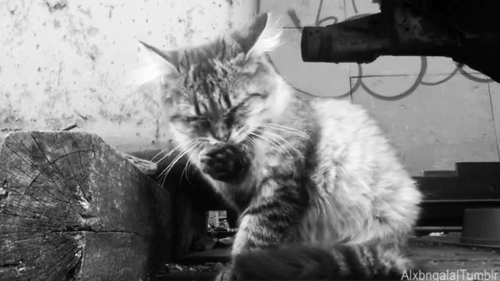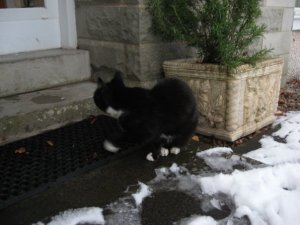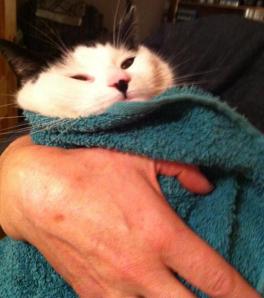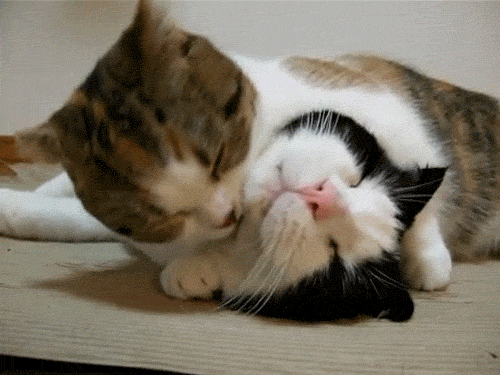I had been lobbying for some months to visit the native cow tribes of the countryside. Visas took time, the locals were not willing to invite another documenter that will fall afoul of their own personal Everest – the Cow Tribe.
Still, after much negotiating, and agreeing that I would not bring a camera, I was able to gain access for three weeks. All I brought with me was a small, slim notebook, a palm computer and a selection of gifts for the Tribe if I was lucky enough to gain access.
I’m met by a friendly local. Like most of the villagers around here their language is almost incomprehensible to those raised in cities and I am thankful for my many years in other countrysides. I need no translator and with a small amount of effort at first I can make myself understood. The locals are wary, they know I will create more work for them, and they insist I stay with them and not in the Tribe. Previous researchers have been lost. I assure them this won’t happen to me and my guide leads me to the Tribe. My initial meeting with them is a dizzying blur of their peculiar naming system and splodgy faces. There’s evidently a strict hierarchy and communication that I am clueless of. The locals are sympathetic but they seem to expect this. I leave the Tribe with some relief that evening and return to my humble dwelling. It’s not perfect, but it is away from the Tribe, and gives me some time to collect my thoughts.
Day Two
I rise earlier than I would usually in order to be present for the Tribe’s morning rituals. Their milking is evidently an important routine, but they greet it with a strange mixture of impatience and irritation that I do not expect. I attempt to immerse myself in their culture, in their worship of Feed Truck. Feed Truck is displeased today and they are not allowed to reach their feed face. This displeases the matriarch 1019. She is a large, old cow with a grey face. She is almost dinosaur like in her physical appearance, with a large arching back and powerful shoulders. She is from another era, and she completely intimidates me.
Day Three
The Feed Truck is pleased with whatever penance the Tribe had paid and they are fed in time. However, the penance appears to be that one of the youngest members of the Tribe lost her sacred collar over night. These tokens appear to have religious symbology for the Tribe. I find the collar in one of their beds and return it to the young member, allowing her to once again approach the holy feed face. Although she reacts with annoyance, I feel as though I have done something for her that no one else could have. I hope her gods are happy with her now.
Day Four
Today is a day of celebration for the Tribe, one of their members is fertile. She is chasing all of the others, even the Matriarch at times. The Tribe tolerate this for a while, but will see her off when she becomes too persistent. I wonder at their behaviour. In her position, they are just as eager to show their amorous intentions. The Tribe appear to place great significance on their fertility, painting themselves differently when they are in-calf. I try to remember this.
The locals assign me an assistant, another traveller like myself. Girl and I are allowed access to the Tribe, although she must return to the locals more often, whereas I am allowed to be isolated with my Tribe.
I realise I begin to think of the Tribe as my own and know that I must curtail this line of thinking. I do not want to become one of those others . . .
Day Five
I am beginning to understand the Tribe. 1019 is the undisputed leader, deferred to in all manners relating to the Feed Truck God and feed face temple. Her ‘muscle’ as it were is 1405, an older Tribe Member who is quite simply massive. I expect some kind of power struggle between them, but 1405 is content in her place. The Tribe members then decrease in number to the youngest ones who are small and still slightly long haired. They are wariest of me and have no desire to communicate, whereas the older Tribe members have begun to approach me, and discuss the Feed Truck God, as well as the importance of their beds and the irritation that is the sludge scraper. I am honoured by their attention.
Day Six
The Matriarch has evidently passed some kind of judgement on me for her acolytes have accepted my presence in every facet of their lives. I am allowed to be present whenever I choose and I find their company soothing. When I return to the locals I am compelled to tell them of the Tribe’s activity. They are interested, but seem concerned at the amount of time I spend with the Tribe and continuously ask if ‘everything is going well?’ I reply that it is. My Tribe is fine. The Tribe members have started to groom me if I wait long enough with them. Their tongues are rough.
Day Seven
The Tribe were greatly disturbed today by a festival that the locals put on. This involved some kind of appearance by someone the locals worship, but who the Tribe regards as a devil. The Foot Trimmer Daemon selected six of the Tribe and I was complicit in this, wishing to observe every aspect of their lives. The Tribe were not pleased with me and I was forced to sacrifice my left index finger by having it jammed between a steel bar and one of the Tribe’s horn butt. The pain is intense but I cannot react as I would normally for the local children are there, and the Tribe know this. I nurse my wounds and retreat, I feel this festival has set my entire study back.
Day Eight
The Matriarch has announced that I may stay an extra day, a reprieve for my sins yesterday. I get the sense that the Tribe has some affection for me as 1825, one of the youngest, starts to eat my sleeve. I record of this in my palm computer which they have taken to calling my little demon. The Tribe accept me and my strange ways as I accept they and theirs. It is a comforting relationship and when I leave in the evening, I am somehow . . . tense.
Day Nine
One of the Tribe’s sister groups roams in a pen near to my Tribe. One of the locals discovered that one of the sisters had trapped her head in a pen. I go to assist, and though she frees herself, I get the feeling the Matriarch is pleased with me. I enjoy my time with the Tribe more than with the locals, and I feel they even enjoy spending time with Girl.
Day Ten
It strikes me today that I misjudged many of the Tribe when I first arrived. I wonder now why I ever thought 1405 was only the ‘muscle’. She is second in command, constantly at 1019’s side and pushing the smaller Tribe members aside. Today she initiates a grooming session with me. I can barely move for excitement, although her strong licks almost send me flying.
Day Eleven
Disaster strikes. The Feed Truck God makes a delay before his morning appearance. 1586, the best singer in the Tribe, raises her voices to the heavens in order to inform them they have forgotten to send their blessed angel. I try to reassure the Tribe that their Feed Truck God will come soon, he has just been delayed, but they disagree. One of them, 1541, who is small and strange looking, suggests we must sacrifice Girl to appease him. I discourage this firmly, and sure enough Feed Truck God appears. 1541 subsides, but she does not go to the feed face temple for some time. I am concerned. Later that evening I realise she is not as young as I first thought, in fact she is one of the older Tribe members, though small. She is also wearing the paint of an in-calf Tribe member, and I am surprised for some reason. She then disappears under my nose and reappears on the wrong side of the gates I promised to man for the locals. I fetch her with little difficulty, but I am informed by the others that she is their shaman.
I return to my dwelling and wonder about this.
Day Twelve
Today my ‘demon’, my palm computer that so fascinates the Tribe breaks. 1541 is watching me from her bed, saying nothing. I spend some time fixing it but I have lost precious notes. I am concerned that the Tribe are saying 1541 caused my demon to flee. I observe their rituals, but I do not believe. If I believed I would be in danger of losing myself. When Girl comes in, 1541 says nothing, but merely turns away.
Day Thirteen
Yet again my ‘demon’ breaks. I replace it with another that the locals have gifted me and it breaks also. I am terrified, and 1541 is watching everything I do. She wants the Girl. I cannot give her that, but I can wake Girl early for an emergency as I try to fix the demons frantically. My demons work suddenly and I sense that 1541 is appeased by Girl’s missed sleep, although I am later told she would have preferred spilled blood.
Day Fourteen
Girl attends the whole of the morning milking ritual, which greatly appeased 1541. I gift the Tribe with the jewellery I have brought and hope they like it. As we are waiting for the afternoon milking ritual to begin, I tentatively begin to groom 1541. The Matriarch is revealed to be in-calf yet again and her paint is changed. This is some celebration for the Tribe, and the Feed Truck God is lenient. I am content to sit among the Tribe that evening, in the sweltering heat, listening to 1584 gently singing as she eats.
Day Fifteen
The jewellery I have provided the Tribe with is now encased with dirt and sawdust, as everything is that the Tribe appreciates. I realise that I am one with the Tribe, that I am Tribe. I lean against 1541 as we wait for the afternoon milking ritual, and one of the younger Tribe members licks the left over feed from my arm.
Day Sixteen
A local invades the Tribe’s territory to provide some essential maintenance. 1599, the Tribe’s best hunter, is assigned to investigate. She once followed a flightless pigeon all the way through the pen, and I watched as she almost caught it before it escape through the fence. The Tribe and I all agreed it was a marvellous feat to even have her nose so close to its tail feathers, though 1599 is a proud individual, and was saddened to lose the bird. Today she investigates the man very slowly, and his power tools. She captures one successfully and he is forced to move.
I have negotiated for extra food from the Food Truck God, and this wins me great approval. With 1599’s success and my own, the Tribe is content this evening.
Day Seventeen
I am supposed to be returning soon, and I barely remember civilisation. I barely remember non-Tribe living. The fumbling of the afternoon milking ritual by the new young local priest irritates the Tribe, and I share their annoyance, share their jubilation when they finally return to the pens. As we wait, I find myself falling asleep against 1541’s flank and she takes me on a dream walk. We are interrupted by a laughing local, but I am oddly touched by 1541’s power.
How will I leave the Tribe when they have so much to teach me?
Day Eighteen
The Tribe do not want me to leave. They are incessantly grooming me, their rough tongues curling around my arms and pulling me into their mouths. I am concerned suddenly about why they were so keen to sacrifice Girl. The Feed Truck God is equally displeased and is late again, the Tribe sing for him and I find myself begging 1541 as my demon begins to play up. I think I will stay.
Day Nineteen
The locals have come for me. They say the Tribe must move on to newer pastures where I may not follow. I notice 1019 has a scratch on her hip that she did not have yesterday and I am suddenly afraid for the old Matriarch. I hope she continues her long and wise life. I hope 1541 remains strong and small. I want to know which of the young Tribe will grow to be as big as 1405, and if 1599 will ever catch her pigeon or if 1586 will ever stop singing. Will 1494 stop kneeling all the time and will 1825 learn that she doesn’t need to perch on the ridge of the feed face temple to get in? All these questions I can not answer because I must leave.
I return to civilisation and it feels odd, strange. I wonder what I will do tomorrow when there is no morning milking ritual for me, and yet for the Tribe it will continue. Their lives will continue as mine does not. I will miss them.



